Venezuela Philampelini:
Eumorpha
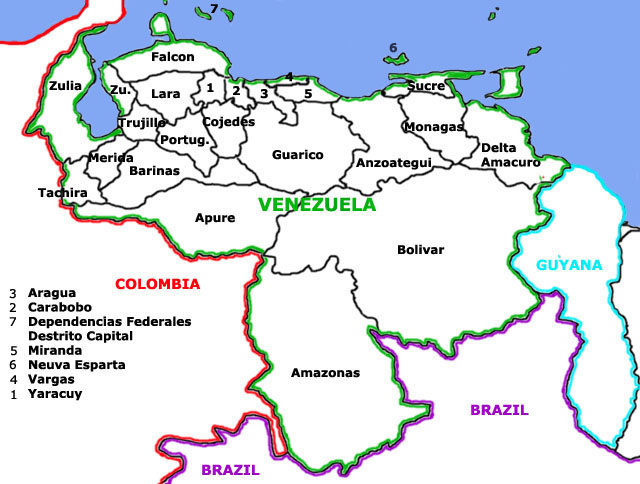 |
|
|
Updated as per personal communication with María Esperanza Chacín; April 1, 2005 Updated as per Hawkmoths of the World Kitching and Cadiou, 2000; May 2011 Updated as per CATE Sphingidae, 2009; May 17, 2011 |
 |
All images I receive remain the property of respective photographers and are credited as such. Data such as wingspan, date, elevation, precise location, etc., is credited to persons who submit same.
I have arranged the images in accordance with my perception of wing characters: predominent markings, shape, colour, size.
There are probably some Venezuelan species not listed below, and there are some species not officially confirmed for Venezuela, although I think they have a good chance of being found there.
All images that I use are credited to respective photographers and those images remain the property of the photographers. Data submissions are also acknowledged.
I hope that over the next twenty years the site can be further refined to allow for the creation of state by state checklists for Venezuela.
Many thanks to those who have already submitted photos and information. The CATE Sphingidae site has been extremely helpful regarding descriptions and determinations. If there are mistakes on this site, they are my own. Bill Oehlke.
Females often have a wing shape or pattern that differs from the males. I hope some day to also have a thumbnail checklist for the females.
 |
Eumorpha fasciatus, the Banded Sphinx |
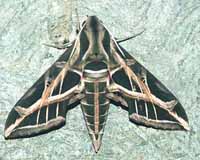 | Eumorpha vitis the Vine Sphinx: Forewing is generally quite similar to fasciatus, but note much longer internal extension of the lowest thin beige post median line into the median area. In fasciatus, this lower thin line in the median area is only a very short dash before meeting the broad transverse lines. Vitis lacks the broad pink band, found in fasciatus, along the hindwing outer margin. 2 |
 | Eumorpha labruscae the Gaudy Sphinx: Fw ground colour bright green to grey-green with a darker triangular median area, delineated by very dark am line and dark median line. There is a brownish blotch near midpoint of outer line of darker triangular area, followed by a beige blotch along the inner margin. 3 |
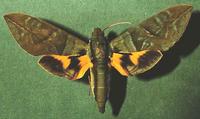 | Eumorpha phorbas: Fw ground colour grey-green with series of lighter grey-green bars, dashes, lines: aml runs straight from costa to i. m.; apical pml runs straight toward intersection of aml and i.m., but is broken at about 40% of its course by an L-shaped line that turns at about 135 degrees toward aml/im juncture. 4 |
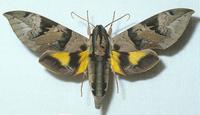 | Eumorpha capronnieri Fw ground colour grey to brown with distinct pattern of mottled green and darker brown areas. Forewing apex is slightly more produced and pointed in capronnieri, compared to phorbas. Note the outward extensions of dark green-brown stripes on abdominal tergites 5 and 6. |
 |
Eumorpha satellitia licaon |
 | Eumorpha anchemolus: Fw o. m. slightly crenulated. Similar to Eumorpha triangulum, but fw upperside pattern less contrasting and variegated. Dark subapical costal patch truncated on Rs4. White fringe along i. m. from body to slightly beyond median rhombiform patch very conspicuous. 6 |
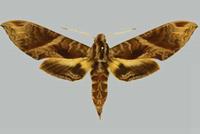 | Eumorpha cissi: Similar to anchemolus, but ground colour: dark greenish-grey; anchemolus: brown. Cissi has more falcate apex. Cissi lacks strongly contrasting white fringe extending (in anchemolus) from body to slightly past dark rhombiform region. Two well defined zigzag lines in pale area along i. m. between dark rhombiform region and anal angle. ? eastesn Colombia |
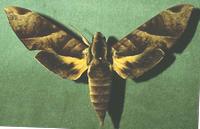 | Eumorpha obliquus: Fw: more glossy grey than anchemolus; three straight oblique parallel lines present in basal area running straight from costal margin to CuP fold; discal spot absent; dark patch near tornus broader than in similar species, rounded triangular; fringe of posterior margin buff, less extensive than anchemolus. |
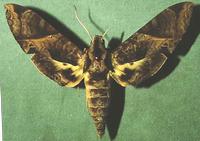 | Eumorpha triangulum: Note the dark trapezoidal patch emanating from the costa just prior to the apex. In E. triangulum this patch continues into the next intraneural segment, giving triangular appearance, while in the very similar E. anchemolus same area remains a trapezoid without "tailed" extension into the next section. Rain forest/cloud forest species unlikely at lower elevations. |
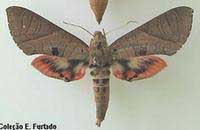 | Eumorpha adamsi: Almost uniformly brown forewing, relatively thin lines, convex forewing outer margin, Similar to Eumorpha translineatus, but distinguishable by bright pink hindwing marginal band and tornal patch. Most pronounced fw line runs obliquely from midpoint of costa toward anal angle. unlikely |
Visit Sphingini: Manduca
Visit Sphingini: Agrius, Amphimoea, Cocytius, Euryglottis, Lintneria, Sphinx
Visit Smerinthini: Adhemarius and Protambulyx
Visit Dilophonotini: Aleuron, Baniwa, Enyo, Kloneus, Pachygonidia and Unzela
Visit Dilophonotini: Aellopos, Eupyrrhoglossum, Nyceryx, Perigonia and Stolidoptera
Visit Dilophonotini: Callionima, Erinnyis, Hemeroplanes, Isognathus, Madoryx, Oryba, Pachylia, Pachylioides, Phryxus
and Pseudosphinx
You are here: Philampelini: Eumorpha
Visit Macroglossini: Hyles and Xylophanes
Use your browser "Back" button to return to the previous page.
This page is brought to you by Bill Oehlke and the WLSS. Pages are on space rented from Bizland. If you would like to become a "Patron of the Sphingidae Site", contact Bill.
Please send sightings/images to Bill. I will do my best to respond to requests for identification help.
 Show appreciation for this site by clicking on flashing butterfly to the left. The link will take you to a page with links to many insect sites. |